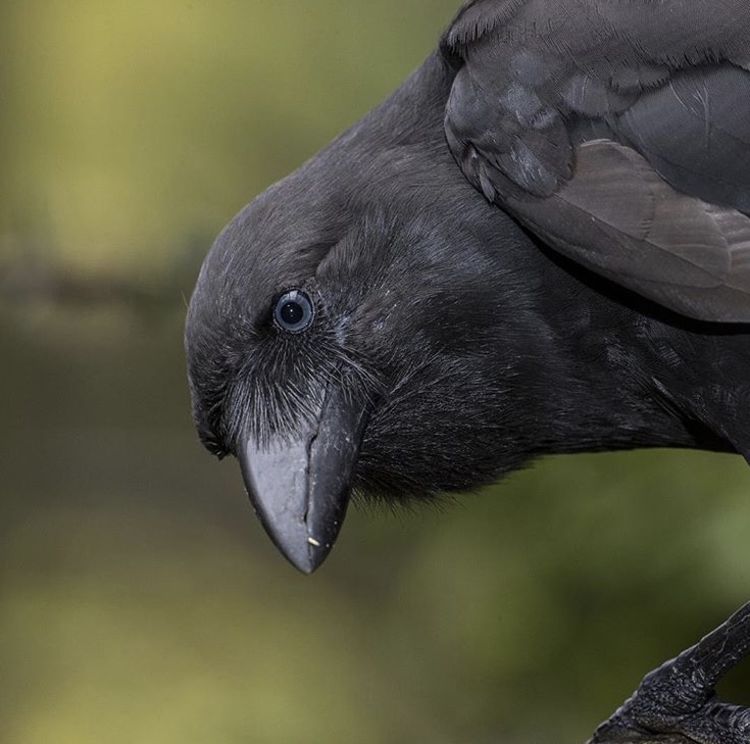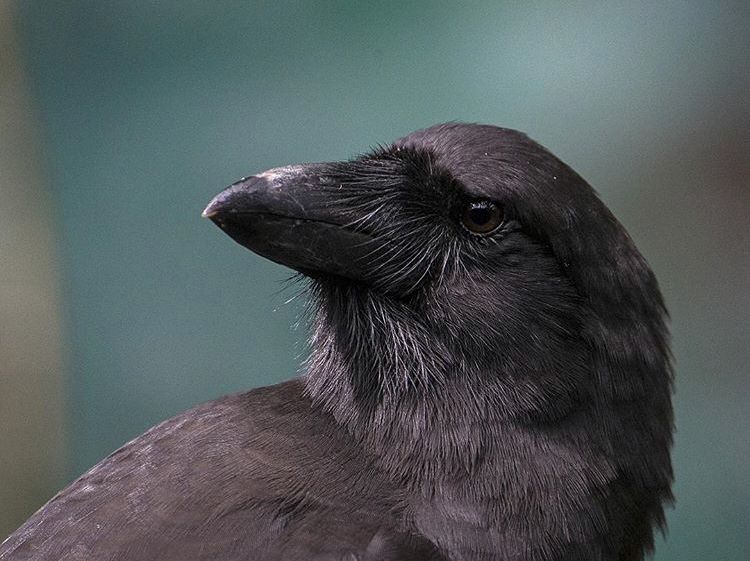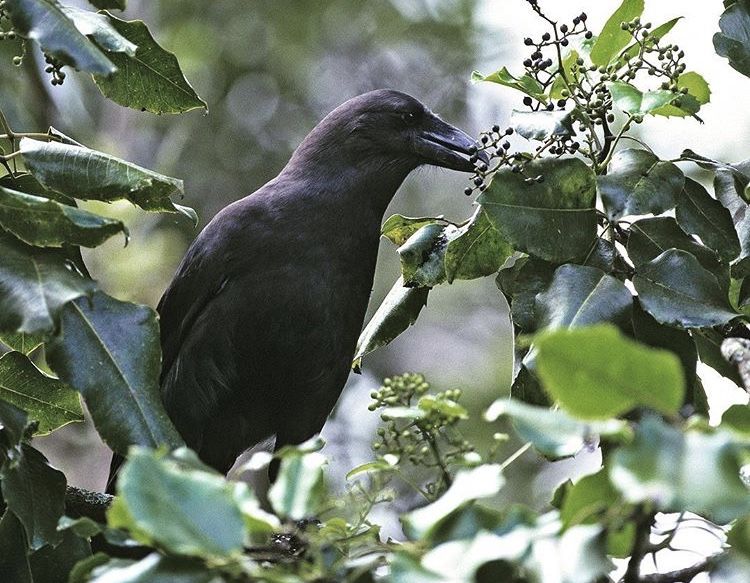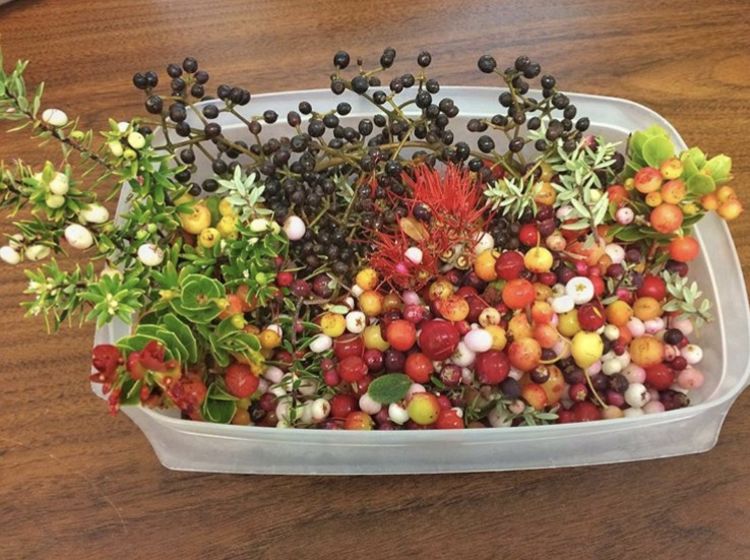Flying Into The Future
Kirie Santos and
The ʻAlalā Project

Hānau ka ʻalalā, ka makua
Puka kāna keiki he alawī, lele
The crow is born, the parent
Out comes its child, an alawī, and it flies
Before there can be the cacophony of sounds that is bird life, the forests must exist. Thus, the Kumulipo begins with the pairing of plants and animals in the ocean with land counterparts. Once the forests take shape, then the fliers come. A flurry of wings and sounds fill the air and life in Hawaiʻi becomes much noisier.
It’s their voices that make these messengers of flight the communicators between realms. Their access to higher spaces makes them a fitting metaphor for chiefs, who descend from gods, don feathers cloaks (ʻahuʻula) and mark their spaces with feather standards (kāhili), both symbols of their status and repositories of their mana. The ʻalalā (Corvus hawaiiensis, aka Hawaiian crow) is one of the birds whose feathers were used in kāhili.
David Malo described ʻalalā as “ʻano ʻē” (different, strange, peculiar, unusual) and said they liked to peck holes in water gourds. ʻAlalā were eaten by people (“He manu ʻai ʻia kēia”) and kept as pets. It is rumored that they are associated with ʻanāʻanā, or dark magic. It is also said that they are ʻaumākua (family guardians) for some people.
Sadly, these relationships to the ʻalalā faded over the late 19th and early 20th centuries, in tandem with the large-scale destruction of their habitat. In 2002, the ʻalalā went extinct in the wild. Luckily, captive breeding efforts had been underway for several years and in 2016, The ʻAlalā Project reintroduced the first cohort of birds into the forests of Puʻu Makaʻala Natural Area Reserve (NAR). There are currently 20 ʻalalā living in the reserve and they are all highly monitored.
That we came so close to losing this bird with its many connections to us, from cosmology to personal family relationships, should shake our very foundation. Yet there are 78 other native Hawaiian bird species that have gone extinct. How many of those were ʻaumākua? Extinction is a scientific frame for species loss, but what are the cultural impacts? Since culture is about contact and experience, the folks at The ʻAlalā Project can help us to better understand what is on the line, as they have re-established a close relationship to this beautiful bird.

Kirie Santos is a young Hawaiian and a member of the predator control crew of The ʻAlalā Project. She generously shared with us her experiences about working with these birds. When she saw them in their native habitat for the first time, she said, “It kind of felt like I was in a movie. It was definitely surreal.” Yet, their sounds felt right to her in that environment. “It’s like what you are supposed to hear when you walk into the forest. It felt almost familiar, even though I hadn’t experienced it before that point in my life.”

Kirie Santos in The ʻAlalā Project shirt done by Kealopiko.
Raised in Puna, Hawaiʻi, Kirie grew up surfing, paddling and enjoying the ocean with her ʻohana (family). She figured marine science would be her path, but after a few volunteer experiences doing terrestrial work, she was hooked. “I was always outside growing up, so it just came really naturally to me.” Once she got her foot in the door she says, “These opportunities just came flying at me.” She didn’t realize that she would actually end up working with birds when she joined Kupu, who placed her on her first paid internship. “They could have thrown me anywhere and I would have been stoked,” she says. It was the ʻAlalā Project that brought her on and it was an eye-opening experience for her.

Kirie Santos in The ʻAlalā Project shirt done by Kealopiko.
Kirie Santos in The ʻAlalā Project shirt done by Kealopiko.
Kirie learned much more about natural resource management than she had expected. “I thought it would be mostly focused on removing invasive [animals], but I learned so much about plants.”
The Puʻu Makaʻala NAR is home to some 176 species of native plants. This 18,730 acre stretch of forest runs across the districts of Puna (ʻŌlaʻa, Waiākea) and South Hilo. Kirie explained that the forest goes from wet to mesic and contains roughly 30 species of plants that provide food for the ʻalalā in the form of fruit. The ʻalalā feed on fruits, thereby ingesting seeds, then fly to other locations and poop those seeds out. Scientists call this seed dispersal. It plays a critical role in forest survival and growth.
Kirie has come to truly understand the interconnectedness of the birds and the plants. “From a cultural standpoint, just being in the forest with these birds, seeing it firsthand, it really solidified the importance of preserving native [plant] species.”
“Everything kind of interplays with each other. If you want to work in one field in conservation, you gotta know the other sides too.”
The predator control crew’s everyday work mostly involves baiting, trapping, monitoring, and removal of mammals that predate on ʻalalā: rats, mongoose and cats. While the first two eat eggs and chicks, cats will hunt and kill full grown adults. Cats also carry a disease called toxoplasmosis that can transfer to birds and kill them. Kirie says trapping is especially intensive on the perimeter of the release area and in grids around the two aviaries where the birds, reared in conservation breeding centers, are taken to acclimate and transition into forest life.
Although her work centers around trapping predators and monitoring their activity, Kirie gets to observe the birds a lot. “It’s pretty insane how smart they are,” she says with confidence, “They love to use tools [in conservation breeding centers]. In the wild, they dig into trees with their strong bills for insects.” Apparently ʻalalā exhibit all sorts of interesting and advanced behaviors. They mate for life, so they will pair up and defend a territory. They may team up and bully another bird to steal its food. “They make trouble to each other,” says Kirie, laughing. Her joy is palpable when she talks about them.
The birds have a wide range of vocalizations. Kirie finds some of them puzzling, “They definitely make some weird noises. Some of them are almost like a wailing or a screech.” She acknowledges that the word ʻalalā is also used to describe the cry of a baby. She says sometimes she will be walking in the forest and hear a really strange sound, only to see a bird and realize that she has heard yet another ʻalalā vocalization.
She laughs when she describes watching ʻalalā bathe. Kirie says a bird will go into a tall ʻōhiʻa or koa tree, find a small pool of water (maybe where a big branch meets a trunk), and have a boisterous bath. It will play and splash around and when it's done, it shakes off the excess water like a dog and fluffs itself up. It might do a bit of preening then, as well.
When asked what it feels like to be around them, Kirie’s voice slows down. She thoughtfully explains that ʻalalā have a very powerful aura and presence. “Sometimes I won’t see or hear them, but I’ll feel like they’re around. Then I’ll look up and there will be one right above me.” She says people who have only heard of their “darker” associations sometimes mistake them for being kind of scary, but she has been lucky enough to feel their intensity and see their playfulness. In coming to know their habitat, she now understands their life-giving capacity. “If you think about their role in the forest, they disperse seeds and regenerate growth.”
“It’s almost like you can feel their presence before you even see or hear them.”
Kirie’s deep understanding of the ecological importance of ʻalalā seems to be underpinned by her personal connection to these birds. She says that losing ʻalalā would be like losing a piece of ourselves and would further distance us from culture. “The loss of a species is one more thing that disconnects us.” She also believes culture and conservation go hand in hand and says, “You can’t preserve natural resources without perpetuating culture.”
Seeing young people like Kirie form a personal connection to ʻalalā is to watch the repair of a cultural link, for culture itself begins at the fundamental level of relationship. If these kinds of connections can be sustained and grown, then maybe our great grandchildren will be able to make kāhili again from the feathers of the ʻalalā. Doesn’t it make sense, however, to simply start by feeling delighted at watching them bathe? By feeling their awesome presence? By removing the threats to their survival that exist because of us? Those privileged enough to experience these things can share their stories with others and help them to form an emotional connection, rather than an intellectual one.
It is that naʻau level understanding that draws people in and drives continued support for future efforts - efforts that will keep the number of birds increasing, help them to start breeding on their own in the wild, and open the way for others to experience their beauty a mau loa aku (forever).
In the words of Kuʻulei Vickery, one of Kirie’s fellow crew members, ʻalalā are a link to the past and the future looks very bright. She said, “Last year I was hāpai (pregnant) and it was surreal to think that my baby in my ʻōpū (stomach) could hear the birds as I walked through the forest. I can’t wait for the day when there will be plenty ʻalalā and it’ll be normal to see them. If not in my lifetime, hopefully my son’s.”
Mahalo to San Diego Zoo Global, Jack Jeffery and The ʻAlalā Project for the beautiful photos used in this story.
A huge thanks to Rachel Kingsley of The ʻAlalā Project, as well as all the partnering agencies: State of Hawai‘i DLNR Division of Forestry and Wildlife, San Diego Zoo Global, U.S. Fish and Wildlife Service, National Fish and Wildlife Foundation, Three Mountain Alliance, Kamehameha Schools, U.S. Geological Survey, National Park Service, PCSU, and the University of Hawai‘i at Hilo.



